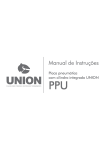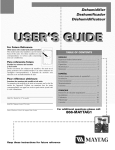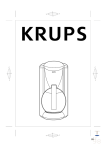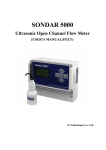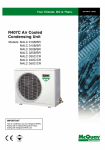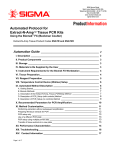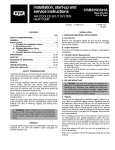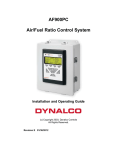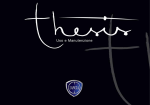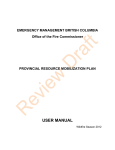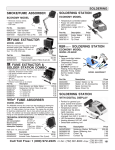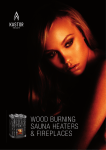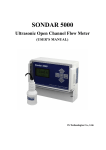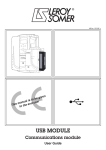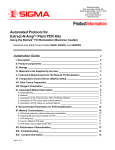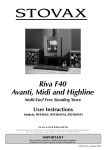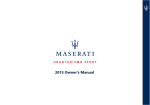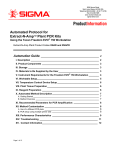Download Check Before Operation for The Electrical Side
Transcript
INDEX
General
Dear Customer
Safety Consideration
Introduction
Nomenclature
Components Description
Outstanding Features
Specification
Standard Features
Optional Features
Microprocessor Controller
Nameplate Description
Installation
Loose Part Check
Storage
Unloading
Operating Space
Site Requirements
Installation
01
Petra Pumping Unit (PPU)
Connection
Mechanical Connection
36
03
04
04
05
16
I
17
20
23
26
31
N
32
32
32
33
D
34
35
36
E
37
37
42
43
X
RWC & PPU Connection
Electrical Connection
02
INDEX
Operation
Before Starting the Unit
First Operation Checklist
Unit Check Before Start
Check Before Operation for The Electrical Side
44
44
45
47
47
47
Sound Power Data
60
General Data Tables
Electrical Data Tables
Pressure Drop Curves
Models Layout
Load Distribution
PPU Refrigerant Schematic Diagram
Refrigerant Schematic Diagram
Wiring Diagram
62
I
Sequence of Operation
Operation Limitation
Maintenance
Trouble shooting
49
50
N
58
64
65
72
D
67
73
74
E
78
X
r
w
c
m
a
n
u
a
l
RWC Manual
Page 01
GENERAL
The following symbols will used in this operational manual to alert you to areas of potential hazard
A NOTE is used to highlight additional data that may be helpful to you.
An IMPORTANT is used to focus upon information which must be noted.
A CATION is used to identify a hazard which could lead to personal or machine injury.
A WARNING is used to identify a hazard which could lead to personal death or machine
destruction or break down.
This manual covers the installation, operation and maintenance of
ensure proper operation and ensures a long service life of the unit.
’s RWC Series. This will
All procedure presented in this manual, like installation, operation and maintenance
must be performed by trained and qualified person
For more information please contact your local
Factory
and service center or refer to
r
w
c
m
a
n
u
a
l
RWC Manual
DEAR CUSTOMER
Page 02
Thank You for choosing
Residential Water Chiller (RWC) unit with hermetic
(reciprocating/scroll) compressor. Please take the time to go through this manual as it contains
valuable information on installation, operation and maintenance of the unit. This will help you to
use your unit for a long time.
Unit capacities in this series range are as follow
RWC: 2-50 nominal tons @ 50 Hz
2-55 nominal tons @ 60 Hz
RWCc:1.9-45.5 nominal tons @ 50 Hz
2.1-56.8 nominal tons @ 60 Hz
If you need any more information about
’s RWC units or other units, please
do not hesitate to contact us at your nearest sales office.
Receiving
On arrival, inspect the unit before signing the delivery note. Specify any damage on the delivery note
and send letter of protest to the last carrier of the goods.
Inspection
Check the shipment received against the shipping list, to make sure that shipment is complete. After
inspecting the unit, protect properly during storage or while moving it to the actual installation site.
To maintain warranty protect unit against adverse weather, theft or vandalism on jobsite.
Take stock all the accessories and loose components that comes with the unit and
compare it with the submitted order list
Damage to Units
Be sure to inspect the unit upon receipt for damage. If the unit has been damaged in transit, file a
claim with the transportation company immediately and advise your insurance company immediately.
Be sure to inspect the unit upon receipt for damage. If damage is found, file a claim
right away with the insurance company
Warranty
warrants all equipment and materials against defects in workmanship and materials for one
year from initial start-up, or eighteen months from delivery (whichever occurs first) unless
extended warranty has been agreed as part of the contract. All warranty claims must specify the unit
model, serial number and order number. These details are printed on the unit identification plate. For
warranty purposes, the following conditions must be satisfied:
The initial start of the unit must be carried out by trained personnel from an Authorized
Service
Center. All the scheduled maintenance operations detailed in this manual must be performed at
the specified times by suitably trained and qualified personnel. Failure to satisfy any of these
conditions will automatically void the warranty.
The warranty is void if the equipment is repaired or modified due to misuse, lack of
maintenance or failure to comply with
’s instructions or recommendations.
If the user does not conform to the above mentioned general notes, it may result
in cancellation of the warranty.
r
w
c
m
a
n
u
a
l
RWC Manual
SAFETY CONSIDERATION
Page 03
Installation, start up and service of air conditioning equipment can be hazardous due to system
pressures, electrical components and equipment location {roof, elevated structure…,etc.}. Therefore,
only trained and qualified installation and service technicians should install, start up or service this
equipment. We would like to remind you that failure to respect installation and maintenance
instructions may void the unit warranty
Follow all safety codes
When working with the equipment, observe precautions in the literature as well as the
tags, stickers and labels attached to the units.
Keep all doors and screws installed on unit while moving unit and installing ductwork.
This will helpensure that the unit stays square, allowing for easier removal of doors after
the ductwork is attached.
Before operating, be sure the unit is properly grounded to prevent injury or death from
electrical shock.
Be sure to disconnect power before servicing this equipment.
DO NOT VENT refrigerant relief valves within a building. Relief valves outlet must be
vented outdoors.
Wear safety glasses and work gloves.
Use care in handling, rigging and setting bulky equipment.
Keep quenching cloth and extinguishers nearby when brazing.
Do not tip units on their side during transportation or installation, or severe internal
damage may occur.
Before driving screws into the cabinet, check on the inside of the unit to be sure the
screw will not hit electrical or water lines.
r
w
c
m
a
n
u
a
l
RWC Manual
Page 04
INTRODUCTION
Residential Air-Cooled Liquid Chillers (RWC) with hermetic scroll or reciprocating
Compressors and R22 or R407-c refrigerant, offers a wide range of sizes to meet the customer
requirement for different applications within residential and commercial buildings.
RWC Chillers are designed to meet the customer requirement by offering state of the art
Low sound, reliable , high energy efficient and small physical footprint chillers. The wide range
cooling capacities and flexible installation arrangement makes it easy to install and maintain.
These Packaged air-cooled water chillers meet the same high engineering and performance standards
that are characteristic of all
Air Conditioning Systems
This manual contains all the information required for correct installation of the unit,
together with operating and maintenance instructions. This manual should be read
thoroughly before attempting to operate or service the unit.
For more technical details, please refer to the nearest Sales Office or
Factory.
NOMENCLATURE
R
W
C
C
350
3
S
S
AC
Coil Corrosion Protection Material:
Residential
AC: Aluminum Fin-Copper Tube
PC: Pre-Coat Aluminum Fin-Copper Tube
CC: Copper Fin -Copper Tube
BC: Coated Copper Fin - Copper Tube
Water
Chiller
S: Hermetic Scroll Compressor(s)
X: Hermetic Reciprocating Compressor(s)
None: R 22
c:
R 407-c
Nominal Sizes:
25 76 260 470
30 105 310 530
40 128 350 580
47 160 390 630
55 210 430
No. Of
Compressors
1,2,3 or 4
S: Same Compressors
D: Different Compressors
r
w
c
m
a
n
u
a
l
RWC Manual
COMPONENTS DESCRIPTION
On/Off Switch
This device is used to connect and disconnect the power to the whole unit
Control Circuit Breaker
(CCB)
This device is incorporated in the unit as part of the control circuit to provide
protection to the control circuit from a short circuit.
The crankcase heater of each compressor can be energized when
this control circuit breaker is switched ON. It is highly
recommended to energize the crankcase heaters of the
compressors 24 hours before operating the unit for the first time
Power circuit breaker (PCB)
The function of the power circuit breaker is to provide protection from
short circuit, for the whole unit or for each motor as well.
Page 05
r
w
c
m
a
n
u
a
l
RWC Manual
COMPONENTS DESCRIPTION
Control Transformer
Transform the voltage from primary voltage (220, 240 volt) into
secondary voltage (24 volt)
ON/OFF Convertor
Converts a 10Vdc signal into an ON/OFF signal via relay, and it is
used to connect and disconnect the fan
Contactor
The contactors are mainly used for controlling 3-phase motors.
The unit should contain all the required contactors to
start all motors such as (compressors, condenser fan
motors).
Page 06
r
w
c
m
a
n
u
a
l
RWC Manual
COMPONENTS DESCRIPTION
Motor Saver
Page 07
r
w
c
m
a
n
u
a
l
RWC Manual
COMPONENTS DESCRIPTION
Page 08
Thermostatic Expansion Valve
This device controls the superheat of refrigerant vapor at the outlet of
the evaporator, it acts as a throttle device between the high pressure and
low pressure sides of a refrigeration system and ensure that the rate of
refrigerant flow into the evaporator exactly matches the rate of
evaporation of liquid refrigerant in the evaporator. Thus, the evaporator
is fully utilized and no liquid refrigerant may reach the compressor.
Service Valve
This is a manual valve located in the liquid line used for
pump down applications and for liquid line accessories
repair or maintenance.
Crankcase Heater
The heater minimizes the absorption of the liquid refrigerant by
the oil in the crankcase during brief or extended shutdown periods.
The heater is located in the bottom cover of the
compressor. The heater fixture must be tight to
prevent it from backing out of the heater well. The
heater eventually burns out if exposed to air for an
extended period
Never open any switch that de-energizes the crankcase heater unless unit is being
serviced or is to be shut down for a prolonged period. After a prolonged shutdown on a
service job, energize the crankcase.
r
w
c
m
a
n
u
a
l
RWC Manual
COMPONENTS DESCRIPTION
Pressure Switches
High Pressure Switch / (Manual Reset)
The switch has fixed, non-adjustable settings, and is mounted in the discharge
side of the compressor. The switch is provided to protect the compressor and
the refrigeration system from unsafe high pressure conditions. If an unsafe
high pressure condition should exist, the switch opens and shuts OFF the
compressor.
The unit control module prevents the unit from restarting. Don't operate the
unit on high pressure more than 410 psig).
Low Pressure Switch / (Automatic Reset)
This switch, which is mounted on the compressor has fixed, non-adjustable
settings. It is of the automatic reset type.
Pressure Switches
Limit Table
Cut Out
Cut In
High Pressure psig
410
275
Low Pressure psig
27
40
Page 09
r
w
c
m
a
n
u
a
l
RWC Manual
COMPONENTS DESCRIPTION
Filter Drier (Disposable Type)
Moisture will enter a system any time it is operated for field
services. A filter drier is a very effective method for removing
small amounts of moisture and contamination. It is installed
in the refrigerant liquid line, so that all the refrigerant in the
circulation passes through the drier, each time it circulates
through the system.
Brazed Plate Heat Exchanger cooler (BPHE cooler)
Cooler The brazed plate heat exchanger is a complete heat
exchanger which consists of stainless steel
plates, permanently brazed together with pure copper. The
plates are stacked together and from flow
chambers for two fluids.
BPHE cooler is used for one stage application with allowable
working pressure (maximum 435 Psi).
The cooler is insulated with 3/4” closed cell foam insulation.
Page 10
r
w
c
m
a
n
u
a
l
RWC Manual
COMPONENTS DESCRIPTION
Sight Glass (Option)
The sight glass allows the operator or service man to
observe the flow of liquid refrigerant. It provides a
warning signal in the event that moisture has entered the
system, indicating that the filter should be changed or
that some action needs to be taken to effectively dry the
system. Clear flow of liquid refrigerant indicates
sufficient charge in the system.
Unit must be in operation at least 12 hours before
moisture indicator can give an accurate reading. With the
unit running, the indicating element must be in contact
with the liquid refrigerant to give a true reading.
Solenoid Valve
This is normally closed with a de-energized coil solenoid valve
and is fitted on the liquid line. The solenoid valve is opened
when the compressor is ON and closed when the compressor is
OFF.
Four-Way Reversing Valves (Optional For Heat Pump Units)
Pilot operated 4-way reversing valves are suitable for heat
pump application on unitary, spilt system type air conditioners,
etc.
4-way pilot valve adoption has an advantage of reliable
changeover operation and is a unique device for short cycle
prevention.
Designed for instantaneous reversing and operations under
small minimum pressure differential between the high and low
side. Pressure drop across the valve, and valve leakage are
minimized.
Provided with drip proof resin encapsulated solenoid coil.
Page 11
r
w
c
m
a
n
u
a
l
RWC Manual
COMPONENTS DESCRIPTION
Suction Accumulator (For Heat Pump Option)
It's purpose is to protect the compressor from damage due to the
sudden return of liquid through suction lines.
Compressors on many air-conditioning units are often subjected to
this sudden return, resulting in broken valves, pistons, connecting
rods, crank-shafts, blown gaskets or bearing failure.
The suction accumulator, will protect the compressor, although
several pounds of refrigerant may suddenly return through the
suction line it does not flood into the compressor. The liquid
refrigerant is temporarily held in the suction accumulator and
metered back to the compressor at a controlled rate, through the
metering orifice.
YTB Thermostat
This component used for ambient temperature
from (15 - 30) C
Temperature Probe (Sensor)
Used to measure inlet/outlet temperatures accurately
Page 12
r
w
c
m
a
n
u
a
l
RWC Manual
COMPONENTS DESCRIPTION
Compressors
Piston Type Compressor
Low sound compressors: with low discharge pulse levels which
insures quiet operation.
Hi efficiency: with high-energy efficiency ratings.
Low foaming mineral base lubricant.
Full maximum load rundown capability
Internal inherent line break motor protection with start winding
protection on single phase models.
Crank case heater on all 3-phase models.
Suction gas motor cooling.
External baked enamel finish provides rust protection.
Aluminum piston /cast-iron ring assemblies that provide
reduced reciprocating mass and positive pressure seal.
Applications and specifications:
All compressors used has the approval to operate as a heat pump compressor.
The motor protector used inside the compressors is mounted internally and its proven design is
the result of extensive laboratory research and field testing. It protects the motor from:
Maximum operating overload.
High voltage
Low voltage
It is both current and heat sensing. It is wired at the connection point of the motor's three legs.
Therefore the protector protects all three legs If a problem occurs with one or more of them, the
protector will break all three phases (the single phase protector protects both the run and start
windings).
Rated load amps. Is the value used for contactor and other electrical component selection.
Page 13
r
w
c
m
a
n
u
a
l
RWC Manual
COMPONENTS DESCRIPTION
Page 14
Compressors
Scroll Type Compressor
Low sound level:
Quieter system, lower applied costs (no sound blanket, no need for
special compressor compartment).
Scroll is the quietest compressor in it's range with the sound level
of 6dB less than the hermetic reciprocating compressor.
Very regular sound spectrum with no peaks (more sound comfort).
Reasons:
Absence of dynamic suction and discharge valves.
Absence of reversing piston strokes.
Double compliance: the forces maintaining both scrolls in axial
and radial, leak-free contacts depends on gas operating pressures; this
prevents excessive contact load and associated noise.
Absence of shut-off noise:
More end-user comfort
Immediate internal pressure balancing (high side - low side) at shut-off.
Low vibration and discharge pulses:
More durable system, lower applied costs (no need for discharge muffler), quieter system.
Smooth, continuous compression process: absence of rapid piston motion.
Each model supplied with rubber vibration absorbers.
High energy efficiency:
Lower energy costs
C.O.P. averages 3.3, this is 5 to 15% more than reciprocating compressors.
Reasons:
High volumetric efficiency (no dead space: no valve plate, no spiral tip-seals; leak-free compression
due to double compliance).
Minimized pressure losses: no valve plate, no internal suction and discharge piping; uniform gas
compression in the scroll pockets at low velocities.
Minimized heat transfer losses: physical separation of suction and discharge gas
High capacity at conditions where it is most needed (high ambient temperature in cooling mode and
heat pump conditions):
More comfort in cooling and heating modes
Reasons
High mass flow at high compression ratios (due to high volumetric efficiency).
r
w
c
m
a
n
u
a
l
RWC Manual
COMPONENTS DESCRIPTION
Page 15
High durability
Less failures
Reasons:
Robust design: three Teflon impregnated bearings; integral cast-iron housing for better compressor
alignment.
IP 54 enclosure class of terminal box.
Scroll inherent durability: few moving parts, low motor strains (always starts unloaded, low
running torque required because compression and discharge is a continuous process).
Spiral surfaces wear in, not out, due to unique compliant design.
Solid state thermal motor protection (Motro Protector) is available.
High charge limit:
Low applied costs (no accumulator, no external check valve in discharge line).
Reasons:
Large internal volume.
Protected under extreme conditions:
Reliable systems in rough applications
Reasons:
Tolerant to returning liquid or debris (double compliance)
Suction screen.
Centrifugal oil pump with filter.
Solid state motor protection module.
Protected against excessive pressure ratios (floating seals).
Protected against excessive discharge temperature (internal temperature sensor located at discharge
port of fixed scroll).
Built-in non return valve in discharge spud
Compact:
Smaller unit
Foot-print of 8.66*8.66 inch, one of the narrowest in the industry.
Serviceable:
Friendly user unit
Pressure taps.
Oil sight glass.
Oil adjustment valve (schrader type).
Du (PTFE) Journal Bearings
r
w
c
m
a
n
u
a
l
RWC Manual
OUTSTANDING FEATURES
Page 16
Superior Efficiency
RWC series exceed ASHRAE 90.1 new efficiency levels at both full load and part load efficiency.
Low Noise Chillers
RWC series offer a low sound power level chillers measured in accordance of BS IS0 3744 standard by
adopting low noise scroll/reciprocating compressors and condenser fans and special design refrigerant
piping.
Compact Physical Footprint
RWC offers a compact footprint to serve the areas and
applications that have a space constrains and it is offer
a close spacing installation.
Outstanding Finishing
All exposed piping including coil headers are epoxy coated for extra protection and long life.
All coils U-Bends are protected with a galvanized steel painted cover plate mounted at U-Bend
coil side the plate covers the whole U-Bends coil side.
All suction lines are covered with rubber insulation wrapped-in cheese clothes and epoxy painted
for extra protection.
Quality Assurance
To ensure the best performance, each unit is 100% factory run tested.
RWC series is produced in ISO 9001-2000 listed manufacturing facility.
RWC series are rated in accordance with ARI standard 550 / 590.
RWC units construction comply with ASHRAE 15 safety requirements.
Easy Installation
Complete factory wiring, easy listing provisions, factory installed options and start up, facilitate quick
and easy installation. A complete factory run test is performed on each unit.
Design Flexibility
Unit Capacities in this series have a wide range depending on design requirements. A wide choice of
chillers capacities and options are available to meet the precise design requirements. The advanced
microprocessor control enable the consumer to the advanced microprocessor control enable the
consumer to select specific operating parameters according to particular needs.
r
w
c
m
a
n
u
a
l
RWC Manual
Page 17
SPECIFICATIONS
Compressor
The compressor used is a hermetic( Piston and Scroll type) refrigerant gas cooled with thermal overload
protection in each phase. The terminal box is rain-tight, direct -on- line starting. With high performance
and efficiency, low sound; so as to match all other Petra products' reliability and efficiency and with
crank case heater for models RWC 40 and above.
Piston Type Compressor
Scroll Type Compressor
Air Cooled Condensers
‘s air-cooled condensers are designed to deliver their respective duties at optimum
performance for all design conditions. Coils are manufactured from seamless copper tubes
mechanically-expanded into aluminum fins. All coils are tested at 450Psi, air pressure, under water
to avoid leakage.
They also undergo dry chemical cleaning after coil manufacturing for optimum system cleanliness.
r
w
c
m
a
n
u
a
l
RWC Manual
Page 18
SPECIFICATIONS
Direct Driven, Condenser Propeller Fans
All condenser fans are of propeller (axial) type, which are directly mounted on the motor shaft. All
fans run at approximately 900/1100 RPM @ 50/60Hz, for optimum fan efficiency and maximum
sound power reduction. Fan blades are made of corrosion resistance material, and are statically and
dynamically balanced before installation. This offers a low noise operation with high efficiency
performance. All condenser fans are equipped with wire guards.
Condenser Fan Motors
All fan motors are of induction type totally enclosed air-cooled, squirrel-cage type, externally thermal
over current protected and with class "F" insulation and IP 55.
Fan Motor
r
w
c
m
a
n
u
a
l
RWC Manual
Page 19
SPECIFICATIONS
Brazed Plate Heat Exchanger cooler (BPHE cooler)
Cooler The brazed plate heat exchanger is a complete heat exchanger which consists of stainless steel
plates, permanently brazed together with pure copper. The plates are stacked together and from flow
chambers for two fluids.
BPHE cooler is used for one stage application with allowable working pressure (maximum 435 Psi).
The cooler is insulated with 3/4” closed cell foam insulation.
BPHE cooler
Shell and Tube Cooler
The cooler is shell and tube type with inner grooved copper tubes for two circuits and more. It is
tested and stamped for refrigerant side working pressure of 360 Psi and a design waterside working
pressure of 150 Psi. The cooler is installed with closed cell foam insulation. Coolers are ASME stamped.
Shell and Tube cooler
r
w
c
m
a
n
u
a
l
RWC Manual
Page 20
STANDARD FEATURES
Construction
Unit Frame
Easily accessible system components.
Galvanized, formed sheet metal chiller base.
Air-cooled condenser allows less installation space requirements.
Easily accessible system components.
Plastic mesh guard around chiller perimeter.
Weather proof with ample space for easy access power and control panels.
Hermetic suction gas-cooled compressor motor.
Modular design with multiple compressor execution, provides flexibility for varying load conditions,
and avoids total shut down of chiller during service of any of the refrigeration circuits.
Heavy structure unit weatherproof electro-static polyester powder paint, oven baked for sheet metal
and multi-epoxy coating for base frame.
Heavy duty mounting chassis for whole unit, welded steel base with lifting lugs painted and epoxy
coated.
Anti-vibration mounts under compressor (Rubber-In-Shear Type).
lifting lugs
Rubber-In-Shear, Vibration Isolator
(Under Compressor)
Refrigeration
Independent refrigeration circuit per each compressor.
Fully charged unit with R22 or R 407c refrigerant.
Liquid, discharge and suction pipes are all of type L hard copper pipes which formed using CNC high
accurate pipe bending machine to minimize pipes brazed joints to increase system reliability.
Epoxy paint for all exposed copper piping system of the refrigeration circuit.
Expansion tank (one in system) - Loose item.
Charging points with charge nipples.
r
w
c
m
a
n
u
a
l
RWC Manual
STANDARD FEATURES
Each refrigeration circuit component:
Thermostatic Expansion Valve.
Liquid line solenoid valve.
Liquid line shut-off valve.
Disposable filter drier.
High/Low safety pressure switches (capsule type; factory pre-set).
Charging points with charge nipples.
Electrical
Weatherproof Electrical Panel: All power and control components including the microprocessor
controller shall be assembled inside electro-static polyester powder paint, oven baked -electrical
panel with index protection of Ip55.
Microprocessor control for full management of the chiller operation and safety circuits.
Smart lead-lag operation for compressors.
Short cycling protection for compressors ( time delay ).
Freeze protection through water out probe.
Low ambient based on ambient control down to 45° F by cycling fan (ON-OFF) for the units
with 2 fans or more. For units with one fan, speed controller can be used as an optional feature.
Control voltage is 220-240V for all components.
Control transformer.
On/Off switch for each compressor.
Starting contactors for compressors and condenser fan motors.
Direct On Line start.
Inherent motor protection for each compressor.
Inherent motor protection for each condenser fan motor.
Control circuit breaker for short circuit protection.
Key-Lock and door handle for electric panel.
Control terminal strip for easy connection with electrical board and easy field installation.
Free terminal for remote ON/OFF connection
Free terminal for general alarm output.
Power supply monitor (phase failure relay). (For unit models RWC 76 and above).
Single point power connection for electrical panel (refer to electrical data tables).
Page 21
r
w
c
m
a
n
u
a
l
RWC Manual
Page 22
STANDARD FEATURES
Key-Lock and door handle
Electrical Panel (Power & Control)
Control Panel
r
w
c
m
a
n
u
a
l
RWC Manual
OPTIONAL FEATURES
Page 23
Construction
Chiller Sound Enhancement Options:
There are 3 options to enhance the chiller sound pressure level;
Sound jacket kit for compressor.
Ultra low fan speed 720 rpm/900 rpm (50/60Hz) and compressor with compartment.
Special design fan blades with external rotor motor and compressor with Sound jacket kit.
Coils Protection material
There are 3 options for coils material:
Polyurethane pre-coat aluminum fins with copper tubes.
Copper fins with copper tubes.
Polyurethane post coat copper fins with copper tubes.
Galvanized wire mesh guard around the chiller perimeter.
Cooler cladding (For shell and tube coolers):
Cooler cladding can be aluminum, stainless steel or polyester painted (22 gauge) galvanized steel.
Cooler insulation:
Cooler can be insulated with 1.5” or more thickness closed cell foam insulation.
Chiller Vibration Isolation:The following options are available for chiller vibration isolation:
Neoprene Rubber Pads.
1” Spring isolator with restraints.
2” Seismic Spring Isolators.
Refrigeration
Heat pump chillers.
Cooler tape heater:
Factory installed heater to protect cooler from freeze-up at low ambient down to (-20°F).
Ice storage option:
Special chillers are available for this option, please consult the factory for more details .
Glycol option:
Used for applications requiring water outlet temperature below 40°F.
Suction Accumulator.
Liquid Receiver.
External Pressure Relief Valve.
Pressure Gauges (High + Low).
Water flow switch Required as a safety interlock to prevent operating of unit without evaporator
flow (available for field installation only).
Moisture sight glass indicator.
Heat reclaim, heat exchanger for hot water supply (de-super heat exchanger).
None-standard water inlet and water outlet temperature range, which are needed for industrial
applications.
Brine application for low working temperature range.
Other refrigerant application (R407c & R134a).
Electronic expansion valve.
Electrical
Microprocessor controller with seven day time schedule and/or serial output port.
High entering water temperature protection.
Automatic or manual pump down and/or pump out upon refrigeration circuit shutdown or start.
Low ambient head pressure control by varying the speed of the condenser fan motor using speed
controller or frequency inverter.
External overload for each compressor.
r
w
c
m
a
n
u
a
l
RWC Manual
OPTIONAL FEATURES
Page 24
External overload for each condenser fan motor.
Earth leakage relay for each compressor.
Earth leakage relay for the whole chiller.
Ampere meter and/or voltmeter installed on electric panel door.
Circuit breaker for each compressor.
Circuit breaker for each condenser fan motor or each pair of condenser fan motor.
Unit mounted fused or non fused disconnect service switch with external handle to isolate unit
from power for servicing.
Main power circuit breaker for whole unit with door isolator.
Building automation system interface.
Can provide a full supervisory system for full monitoring of chiller operation.
This includes hard ware devices and software program.
Main Function of Supervisory System
Modification of control parameters of each single connected instrument.
Local or remote supervisory system.
User- friendly interface.
Reading for the temperature sensor incorporated in the unit.
Status of the unit (ON/OFF, alarm, stand by).
Alarm management of the unit includes:
Display message with detailed alarm description.
Print out in real time of detected alarm.
Fax messages with alarm description and sender identification.
Transmission of telephone messages (GSM).
Unit set points.
Water Pumping Unit (PPU) with Buffer Tank
Pumping Unit (PPU) includes the hydraulic components necessary for chilled water for use
with RWC units. The PPU are designed for easy connection and quick integration into chilled water
system equipment, there by minimizing site labour requirements.
The PPU Provides the following standard features
Heavy gauge galvanized steel casing, with polyester epoxy powder electrostatic paint, oven baked for
outside use.
Water pump with dynamically balanced impeller mounted directly into the motor drive shaft with
mechanical seal to prevent leaks.
Buffer tank, insulated with 0.75 inch thick rubber foam insulation for protection against freeze-up
and reduce heat losses.
Buffer tank, made of 0.12 inch galvanized steel to cover a wide range of applications, fitted with
manual air vent, make up and drain.
The whole pipe work assembly is insulated galvanized steel material.
Expansion tank come in a closed vessel system, pressurized valve, protected by a cap, ensures that
constant pressure is maintained in the system.
Rubber mounted water pump.
Two isolating valves.
r
w
c
m
a
n
u
a
l
RWC Manual
OPTIONAL FEATURES
The PPU can also provide the following optional features
Pressure gauges in the water pump inlet and outlet .
Water strainer, built into the return water pipe .
Globe valve to be installed on water pump discharge .
Mixing tank for industrial applications and process .
Contractor for each pump (mounted and wired in RWC electrical panel).
External overload for each pump.
1
Water Out
2
Air Vent
3
Make Up
4
Water In
5
Drain
Page 25
r
w
c
m
a
n
u
a
l
RWC Manual
MICROPROCESSOR CONTROLLER
Page 26
For more information about these controllers please refer to the PETRA Mark II and
Mark VII-2 controller user’s manual
'S microprocessor controller is engineered to meet the most demanding requirements of all
control and data monitoring applications. It could be activated to perform different functions for
cooling and heat pump applications.
However, in order to render the microprocessor control and peripherals easy to use by all skill levels of
service teams, only necessary function for safety sequence of operation and alarm function are activated
as standard.
In standard execution, while using the microprocessor for chiller control, it communicates with the
standard conventional control such as, high pressure, flow switches, etc. thus allowing the service
technicians to inspect and maintain such devices in the conventional manner.
Microprocessor controller is a standard feature on all units
Mark II Controller
Advantages
(For units including 1 or 2 Compressors)
Extremely compact dimensions
Excellent reliability
Icon ergonomic display
Simple wiring.
Modular architecture.
Power ON indication light.
Connection to remote terminals.
Built in real time clock card.
Temperature reading °C or °F.
Flash memory to prevent data loss in case of power failure.
Modification of the fundamental operating parameters (set points, differentials,
alarm thresholds, time settings) password protected access levels.
Built in keypad, LED display.
r
w
c
m
a
n
u
a
l
RWC Manual
MICROPROCESSOR CONTROLLER
Main Functions
Temperature control on water inlet.
Fan control.
Complete alarm management.
Compressor Time Management.
Pump Management.
Automatic lead/Lag function.
Auto restart after power failure.
Connection to remote terminals
Pump Time Management
Temperature reading °C or °F
Anti-Recycling timer, to limit number
of compressor starts per hour.
Smart defrost management
(for optional heat pump units only).
Displayed Data
Compressor and Fan status.
Compressor operating hours.
Pump operating hours.
Chilled water temperature (leaving and entering).
Ambient temperature.
Head Pressure Control
By (ON/OFF) condenser Fan (standard).
By providing analogue output signals for fan speed controller (Optional).
Alarm Management
Trip indication light.
Visible alarm code.
Anti freeze function.
High, low-pressure alarm.
Compressor thermal alarm.
Flow switch or pump interlock alarm.
Anti-frost alarm.
Probe error alarm.
Condenser fan motor alarm.
Devices Controlled
Compressors
Condenser fans
Reverse cycle valves
Water pumps
Anti-freeze heaters
Alarm signaling device
Page 27
r
w
c
m
a
n
u
a
l
RWC Manual
MICROPROCESSOR CONTROLLER
Page 28
Remote Control (optional)
Extended wall mounted display for remote control up to 492 ft.
External communications (optional)
RS 485 interface card to connect the controller to a supervisory network
Petra software to communicate with a remote control room through modems for monitoring and
controlling the unit providing complete supervision for all functions, setting and alarm condition
Serial Converter 455
Advanced
Controller
Advanced Petra Controller (For units including more than 2 Compressors)
r
w
c
m
a
n
u
a
l
RWC Manual
MICROPROCESSOR CONTROLLER
Page 29
Advantages
Built in keypad, ease of use with 4row/20column LCD display.
Built in real time clock.
Multi-language management.
Modification of the fundamental operating parameters (set points, differentials, alarm thresholds,
time settings) password protected access levels.
Daily, weekly and holidays management.
Extended wall mounted display for remote control up to 492 ft. (with external keypad only)
(optional).
Direct printer connection (optional).
Demand limiting function (optional).
External set point reset (optional).
Main Functions
Temperature control on water inlet/outlet.
Smart defrost management (for optional heat pump units only).
Fan control.
Complete alarm management.
Compressor Time Management.
Pump Management.
Automatic lead/Lag function.
Anti-Recycling timer, to limit number of compressor starts per hour.
Daily, weekly and holidays management.
Demand limiting function (optional).
Automatic Pump down (optional).
External setpoint reset (optional): due to external analogue signal for
remote modification of setpoint (4-20 mA or 0-10 Vdc).
Forcing device ON/OFF (refer to manual operation).
Auto restart after power failure.
Displayed Data
Unit Status.
Freon Type.
Unit Cooling capacity (T.R).
Compressor and Fan status.
Compressor operating hours.
Compressor starts number
Pump operating hours.
Compressor Ampere reading (Optional).
Compressor Suction/Discharge Pressure readings (Optional).
Chilled water temperature (leaving and entering).
Ambient temperature.
Value of analog output (fan inverter) (Optional).
Compressor Suction/Discharge Temperature readings (Optional).
Status of high and low pressure switches.
Status of water flow switch.
Status of all inputs and outputs
Automatic Pump down (optional).
r
w
c
m
a
n
u
a
l
RWC Manual
MICROPROCESSOR CONTROLLER
Alarm Management
Alarm history.
Visible full text alarm message.
High / low ambient temperature protection.
Anti freeze function.
High T protection (across cooler) to prevent unit from working under low evaporator flow.
Trip indication light.
High, low-pressure alarm.
Compressor thermal alarm.
Flow switch or pump interlock alarm.
Anti-frost alarm.
Probe error alarm.
Condenser fan motor alarm.
Water out high/low temperature.
Water in high/low temperature.
Devices controlled
Compressors.
Condenser fans.
Reverse cycle valves (for optional heat pump models).
Water pumps.
Anti-freeze heaters.
Alarm signaling device.
Liquid line solenoid valves (optional for Automatic Pump Down).
External communications (optional)
Building Management System using different protocols (BacNet, MODBUS,
Johnson Controls Metasys and LON Talk).
Building Management System using digital inputs and outputs (Hard wire).
GSM Protocol allows sending and receiving SMS messages, which
could be used for signaling active alarms and resetting them where possible
using a GSM mobile phone.
RS485 serial board for Supervisor and Tele-Maintenance.
RS232 Modem interface card.
Page 30
r
w
c
m
a
n
u
a
l
RWC Manual
Page 31
NAMEPLATE DESCRIPTION
ENGINEERING INDUSTRIES CO.
P.O.BOX 141351 Amman 11814 JORDAN
MODEL
REF No.
SERIAL No.
NOMINAL POWER SUPPLY VOLT/Hz /Ph
QTY
VOLT
LRA
RLA
Max. Amp
hp
QTY
VOLT
LRA
RLA
Max. Amp
hp
QTY
VOLT
COMP. MOTOR A
COMP. MOTOR B
Ph
kw
FLA
COND. FAN MOTOR A
COND. FAN MOTOR B
EVAP. FAN MOTOR
ELECTRIC HEATER
Psig
COIL TEST PRESSURE
MINIMUM WATER
LOOP VOLUME (GAL)
REFRIGERENT
CHILLER MINIMUM
WATER FLOW RATE (GPM)
Manufacturing Year
Made in Jordan
A
RWC Nameplate with difference compressor
ENGINEERING INDUSTRIES CO.
P.O.BOX 141351 Amman 11814 JORDAN
SERIAL No.
MODEL
NOMINAL POWER SUPPLY VOLT / Hz /Ph
QTY
Hz
VOLT
Ph
LRA. EA
Max.
AMP EA
KW. EA
FLA. EA
COMPRESSOR MOTOR
COND FAN MOTOR
COIL TEST PRESSURE
Psig
REFRIGERANT
REFERENCE No.
RLA/COPM
MINIMUM WATER
LOOP VOLUME (GAL)
CHILLER MINIMUM
WATER FLOW RATE (GPM)
Made in Jordan
D
RWC Nameplate with similar compressor
When the unit arrives, compare all nameplate information with the data of submitted
order.
r
w
c
m
a
n
u
a
l
RWC Manual
INSTALLATION
Page 32
Loose Part Check
Loose items appearing on the submitted order list should be inspected to verify receipt of the correct
quantity of each. Typical items to check in RWC are listed below:
Expansion tank
Water switch (optional)
Storage
If the RWC units are to be stored, before installation, it is important to take the following precautions:
Keep the unit in a safe area, away from the construction site in order to maintain the integrity of the
unit.
Keep the protective packing of the unit until it is finally installed. If the packing is torn or lost,
protective covering should be provided to avoid subjecting the unit to site and weather conditions,
and manipulation.
It is recommended that the unit is periodically inspected during storage
Moisture, debris, and minerals can cause permanent damage to the components
r
w
c
m
a
n
u
a
l
RWC Manual
INSTALLATION
Page 33
Unloading
These units are designed for overhead rigging. So for proper unloading and handling, a suitable crane
is needed. Use wear flex slings. All units are supplied with lifting lugs on base sides, spreader bars
should be used to keep cables or slings clear from the unit sides to avoid damages for unit frame.
Do not use metal slings to lift the machine because it might damage the unit. Use wear
flex slings and do not use forklift trucks on the units
r
w
c
m
a
n
u
a
l
RWC Manual
INSTALLATION
Page 34
Operating Space
When installing the unit consider the followings:Foundation should be made of flat-leveled concrete or steel stand.
Free space beside the condenser coil.
Free space on both sides of the unit for service and maintenance (if there is no barrier on adjacent
wall).
Free space of not less than 3 meters above the condenser fans should be available.
Once the unit is in place. Check again that the unit is leveled.
r
w
c
m
a
n
u
a
l
RWC Manual
INSTALLATION
Page 35
Site Requirements
To achieve optimum performance and free maintenance it is essential to prepare an installation site
meets with the location and space requirements for the model being installed.
The unit site should be selected for minimum sun exposure, and far away from any
source that may attack any parts of the unit.
is not responsible for equipment problems resulting from an improperly
designed or construction foundation.
RWC units may be locate as two type:
Ground Level Units
Roof Mounted Units
RWC must be installed with adequate vibration isolation beneath the unit to prevent
any vibrations, which is might be transmitted to the building.
Do not locate the RWC unit beside or closed to other building or large building, because
it might reflect the sound back, this may attack the sound sensitive receiver.
On rooftop locations, RWC should locate on a place with adequate structural strength
to tolerate its weight and to be more safe for the whole building.
r
w
c
m
a
n
u
a
l
RWC Manual
Page 36
INSTALLATION
Installation
Establish position where unit is to be installed; make four holes in the ground for double-thread
anchor bolts. Place the unit properly and fix into the anchors. Make sure the unit is properly leveled.
Install and connect pipes between the RWC unit and your system as follows:
If the RWC is ordered with system water circulating pump you just have to connect the supply and
return pipes
If the RWC is ordered without system water circulating pump, selection of pump is based on water
flow rate (gpm) and total pressure drop in system.
Petra Pumping Unit (PPU)
PPU
MODEL
Water
Connection Size RWC unit
(in)
PPU
MODEL
X (mm)
Y (mm)
Z (mm)
PPU75
700
790
900
PPU100
700
790
900
PPU125
1000
1000
1150
PPU150
1000
1000
1150
PPU200
1000
1000
1150
PPU250-1
1000
1000
1150
PPU300
1000
1000
1150
PPU
MODEL
Water
Connection Size RWC unit
(in)
PPU75
0.50
RWC 25
PPU200
1.25
RWC 160
PPU100
0.50
RWC 30
PPU200
2.00
RWC 210
PPU125
0.75
RWC
40-55
PPU250
2.00
RWC
260&310
PPU150
1.00
PPU300
2.50
RWC
350-470
PPU150
1.25
PPU300
3.00
RWC
530-630
RWC 76
RWC
105&128
r
w
c
m
a
n
u
a
l
RWC Manual
Page 37
Connection
Mechanical Connection
Chilled Water Piping
Once the unit has been located in its final position, the chiller water piping may be connected.
Stop valves should be installed in all lines to facilitate servicing.
Flexible connections should be installed on the cooler inlet and outlet to prevent transmission of
water pipe vibration.
Drain connections should be provided at drain connection of the cooler for complete drainage of the
cooler.
Air vent or small valves should be installed on the cooler to facilitate servicing for water or fluid flow
balancing. Locate valves in the return and supply cooler water of fluid lines as closed to the cooler as
possible.
A strainer must be installed in the cooler inlet line just ahead of the cooler. This is important to
protect the cooler from entrance of large particles which could cause damage to the cooler.
(Recommended 40 mesh strainer)
Thermometers and pressure gauges could be installed in the inlet and outlet water lines.
A chilled water flow switch could be installed in the leaving water piping of the cooler. There should
be a straight horizontal run of at least 5 diameters on each side of the switch. Choose the right size
of the flow switch blade which complies with the pipe in which its installed. The switch to be
wired to terminals located in the control panel, as shown on the unit's wiring diagram.
‘S cooler could be supplied with two types of water or fluid connections:
A threaded male connection for small size cooler.
A flexible connection.
Upon receiving the chillers, check the type of connections. If it is of the threaded connection type,
use an adaptor of the same cooler inlet and outlet sizes and connect directly. The other connection
is a flexible connection with clamps after installing the flexible joint, apply a suitable weld to
connect the water or fluid pipe to the flexible connection.
Connection Pipe
Flexible Joint
Threaded male connection
r
w
c
m
a
n
u
a
l
RWC Manual
Page 38
Connection
All piping works to and from the cooler must be designed taking into considerations the followings:
Piping should be kept free of all foreign matters.
Avoid elbows, tees, and valves which decrease the pump capacity. All piping should be kept as
straight as possible.
All piping must be supported independent of the chiller.
The chilled water piping system should be laid out so that the circulating pump discharges directly
into the cooler. The suction for this pump should be taken from the piping system return line.
Flushing the chilled water piping from any foreign material before the system is placed into
operation, should be done without cooler connection to the system.
Don't flush any foreign material into or through the cooler; it should be done without
cooler connection to the system.
Size of Piping:
RWC Models
25
30
40
47
55
76
105
128
160
210
260
310
350
390
430
470
530
580
630
Water Connection
Inlet/outlet
50 Hz
60 Hz
1.25"
1.25"
1.25"
1.25"
1.25"
1.25"
1.25"
1.25"
1.25"
1.25"
1.25"
1.25"
1.25"
1.25"
1.25"
1.25"
1.25"
1.25"
2.00"
2.00"
2.50"
2.50"
2.50"
2.50"
3.00"
3.00"
3.00"
3.00"
3.00"
3.00"
3.00"
3.00"
3.00"
3.00"
3.00"
3.00"
3.00"
3.00"
r
w
c
m
a
n
u
a
l
RWC Manual
Page 39
Connection
Minimum Flow Rate RWC
Minimum Cooler Flow Rate
[GPM]
Model
RWC
RWC-25
RWC-30
RWC-40
RWC-47
RWC-55
RWC-76
RWC-105
RWC-128
RWC-160
RWC-210
RWC-260
RWC-310
RWC-350
RWC-390
RWC-430
RWC-470
RWC-530
RWC-580
RWC-630
10.0 F Water Temp . Diff.
Between inlet & outlet
Water Temp .
50 Hz
60 Hz
50 Hz
60 Hz
3
4
24
27
4
4
28
31
5
6
37
43
6
7
42
47
7
8
48
56
9
11
66
77
13
15
93
110
17
19
120
141
19
22
137
159
25
30
184
220
35
41
250
297
39
46
285
332
44
52
320
379
50
60
365
432
52
62
377
447
57
67
417
486
65
80
473
578
71
84
518
609
78
91
564
658
Minimum Flow Rate RWCc
Minimum Cooler Flow Rate
[GPM]
Model
RWC c
RWCc-25
RWCc-30
RWCc-40
RWCc-47
RWCc-55
RWCc-76
RWCc-105
RWCc-128
RWCc-160
RWCc-210
RWCc-260
RWCc-310
RWCc-350
RWCc-390
RWCc-430
RWCc-470
RWCc-530
RWCc-580
RWCc-630
Minimum Loop Volume
[Gallon]
10.0 F Water Temp . Diff.
Between inlet & outlet
Water Temp .
50 Hz
60 Hz
Minimum Loop Volume
[Gallon]
50 Hz
60 Hz
3
4
23
27
4
4
27
32
5
6
36
41
5
7
37
48
6
7
47
54
8
10
61
75
12
15
87
110
16
20
118
143
19
22
136
160
24
29
177
211
34
40
245
288
38
45
275
325
43
51
309
369
49
58
358
420
51
60
371
435
56
65
406
473
65
78
469
568
70
82
507
597
76
89
550
644
r
w
c
m
a
n
u
a
l
RWC Manual
Page 40
Connection
RWC
with brazed plate cooler
r
w
c
m
a
n
u
a
l
RWC Manual
Page 41
Connection
RWC
with shell and tube cooler
r
w
c
m
a
n
u
a
l
RWC Manual
RWC & PPU Connection
Page 42
r
w
c
m
a
n
u
a
l
RWC Manual
Connection
Page 43
Electrical Connection
Power
Power wiring must be provided through molded case circuit breaker (MCCB) or fused disconnecting
switch with the recommended rating (refer to electrical data tables) and according to the local code
requirements.
Each unit is provided with an electrical cable inlet to supply the unit with the specified power rating.
By referring to the nameplate, you can check the maximum operating current, voltage supply and
operating frequency.
The unit should be grounded in accordance with the local codes.
Control
Each chiller is provided with terminal strip for easy connection of external devices to the control
panel.
Some external devices should be connected in the field such as (water flow switch, auxiliary contact
from the chilled water pump starter, general alarm signal, etc.). These signals should be interlocked
with the control panel as illustrated in the electrical control diagram.
Refer to the wiring diagram attached with the unit for interlocking signals with the control panel.
External devices that should be field installed indicated by dash dot lines in the wiring diagram.
R.S. Terminal
These two terminals can be used for remote control (enabling/disabling) of the unit and can also be
connected with the B.M/System. These terminals must be jumpered if they are not intended to be
used (as indicated on wiring diagram)
These two terminals should be connected to volt-free contacts
General alarm terminals
These two terminals can be used for the remote fault indication which can also be used with the
B.M System to indicate the faulty of the unit. These terminals are potential free terminals.
W.F.S (Water Flow Switch)
These two terminals are available in chiller units, and must be connected without any voltage
(potential free terminal). These terminals exist to protect the unit from starting without the
correct water flow.
P.I Terminal (pump interlock)
These two terminals are available in chiller units, and must be connected with the auxiliary contact
at the pump controller. These two terminals exist to ensure that the chiller starts only after the
pump has started..
r
w
c
m
a
n
u
a
l
RWC Manual
Page 44
OPERATION
Before Starting the Unit
Check the electrical connection for tightness.
Switch on the main power supply.
Use the following formula to determine the present voltage imbalance.
Example:
Present Voltage Imbalance
100 x Max. Voltage Deviation
Supply Voltage
Average Voltage
AB
BC
AC
Average Voltage
= 460 volt/3ph/60Hz
= 463 volt
= 462 volt
= 460 volt
= 463 +456 + 458
3
= 459 volt
Determine maximum deviation from average voltage:
A
B
C
AB
BC
=
=
AC
=
463 – 459 = 4v
462 – 459 = 3v
460 – 459 = 1v
Motor
Maximum deviation is [4v]. Determine present voltage imbalance:
Voltage imbalance
= 100 x 4
459
=
0.87 %
The amount of phase imbalance is satisfactory, as it is below the
maximum allowable phase imbalance value [2%]
Contact your local electric utility company immediately, if supply voltage phase
imbalance is more than 2%.
Check that the voltage monitor [Phase Failure Relay Lamp] is ON, and check that the setting is as
specified on the nameplate. Switch the control circuit breaker ON to energize compressor crankcase
heater.
Crankcase heaters are wired in the control circuit, so they are always operable when the
control power supply disconnect is ON, even if any safety device is open or the unit
switch is in the OFF position.
Start unit under supervision of qualified service technician
r
w
c
m
a
n
u
a
l
RWC Manual
OPERATION
First Operation Checklist
Page 45
r
w
c
m
a
n
u
a
l
RWC Manual
OPERATION
Page 46
r
w
c
m
a
n
u
a
l
RWC Manual
OPERATION
Page 47
Unit Check before Start
Ensure that all piping has been completed.
Check for refrigerant piping leak.
Open liquid line valve for each system.
Ensure water pumps are on. Check and adjust water pump flow and pressure drop across the cooler
Verify flow switch operation.
Check the control panel and compressor electrical box to assure it's free of foreign material.
Be certain all water temperature sensors are inserted completely in their respective wells and are
coated with heat conductive compound.
Ensure that thermal expansion valve bulb are strapped and well insulated from other than suction
temperature effect onto the suction line.
Check before Operation for the Electrical Side
These check need to be performed sequentially:
The main cable for the power supply of the unit is as the manufacturer recommendation (refer to
the electrical table page 9 for the selection of the main power supply cable).
Proper disconnect main power switch is installed beside the unit for emergency or for maintenance
purposes.
The chiller is supplied through main power circuit breaker or fused disconnect switch (refer to the
attached electrical table for the proper selection of the circuit breaker size).
All field connection wrings were connected properly to the control terminal such as:Water flow switch signal
Pump inter lock signal
General alarm signal
Remote switch signal
Refer to page (electrical field wiring) for more information Also it is important to refer to the wiring
diagram for the exact field wiring connection. (field connection is represented by dash dot lines on the
wiring diagram)
Make sure that no obstacles exists that may stop the condenser fan(s), please test by moving the
fan(s) by hand, also check direction of rotation.
Inspect visually for any loose wires.
Sequence of Operation
Operation of the chiller is best understood by referring to the relevant power and control diagrams that
are supplied with the unit.
The control panel layout (part of the wiring diagram) shows the location of each electrical component
that is installed inside the electrical panel, such as (contactors circuit breakers, controllers, etc).
The power diagram shows the power connection for each motor. (D.O.L) Direct on Line starting
method will be used as standard connection for all motors.
Before starting the chiller
Make sure that:
The main incoming power supply is as per nameplate specification and the main power supply
cables are well tightened and in the right sequence.
Switch On the Main Power Circuit Breaker (MPCB) (supplied by others), this will energize the
(PFR) Phase Failure Relay (Voltage Monitor), if installed, which will sense the main incoming
power supply and will give Red Led signal if one of the following conditions was detected:
Lose in one of the phases at the main power terminal.
Phase reversal between two phases at the main power terminals.
Voltage drop in the main power supply that exceeds more 10% of the set value.
3-Phase unbalance.
Over Voltage.
The (PFR) Green LED signal indicates correct power supply.
Check the water flow rate (GPM), also check that system does not contain air bubbles and the
system water pump is consuming normal current (amps).
r
w
c
m
a
n
u
a
l
RWC Manual
Page 48
OPERATION
Chiller Starting
At the time the CCB is ON, this will energize:
The compressor crankcase heaters (if available)
The compressor motor protections (if available)
The control transformer that supplies the power for the controller
You must keep this situation for around 24 hours. If the chiller is going to be started for the first time
or if the chiller has been idle for long period of time.
The controller will start its self-diagnostic check, if all checks were satisfied and found correct.
Enables unit operation from local keypad, digital input, or Building Automation System.
The controller will start its normal operation by giving the START signal for the system water pump.
Switch on the switch related to each compressor on the control diagram.
The controller will read the water temperature and compare it to the set point.
During the P.B (proportional band) the controller will calculate the number of stage that must
start to meet the cooling or heating load demand.
ON
OFF
SET
Differential
Controlled measurement
Proportional Band Control for 2 Compressors
The controller will operate the compressors according to the lead-lag function that is the
compressor with the minimum number of operating hours should start first. This is to ensure
equal operating hours for each compressor.
Chiller Shut down
Controller will continue operating the unit until the water temperature is satisfied, the controller will
switch off the lag compressor unloading the unit, if the load still decreasing the controller will switch
off the next lag compressor.
When switching off a compressor the following action will be taken:
Shut off the liquid line solenoid valve LSV1.
The compressor crankcase heaters will energize keeping the small amount of refrigerant in the
heat exchanger from migrating to the compressor.
Chiller alarms
If any abnormal condition occurred the controller will:
Take the correct action, stop the compressor or the complete unit. Give alarm signal on the display to
inform the user with the error condition.
Energize the general alarm relay for remote indication of the error condition.
r
w
c
m
a
n
u
a
l
RWC Manual
Page 49
OPERATION
Mark II Controller
Refer to the error code displayed on the keypad and compare it to the error codes table (attached with
the wiring diagram) you can find exactly the location of error that had stopped the unit.
Refer directly to text alarm message.
Some of the error signals are manually reset others are automatic reset.
For the manual reset alarms you might need to:
Reset the alarm from the external device (such as high pressure) or/and
From the reset button on the keypad of the controller.
For the automatic reset, no need for user intervention, the controller will take the proper action
automatically.
Operation Limitation
Temperature
If the unit is to be used in an area with high solar radiation, unit should be mounted, so that the
control box is not exposed to direct solar radiation (sun light). (Refer to the Temperature Table below)
* LWT: Leaving Water Temperature
[But upon a brine chiller application the minimum
cooler LWT will be lower]
Temperature Table
Maximum Ambient Temp
°F
125
Minimum Cooler [LWT]*
38
Don't operate the chiller at water temperature below 38°F. Applications in that range
require chillers with factory modification for brine duty. Contact your
representative for more details.
Low Ambient Temperature (optional)
If the chiller is intended to be used at low ambient condition (<45°F). Low ambient kit must be added
to the chiller control panel. This is can be achieved through varying the speed of the condenser fan
motor by using frequency inverter or voltage speed regulator. The speed of condenser fan motor can be
regulated with reference to the ambient temperature to maintain constant condensing pressure in the
condenser.
r
w
c
m
a
n
u
a
l
RWC Manual
MAINTENANCE
Page 50
Each RWC unit is designed and constructed for minimum maintenance and dependable operation.
However, certain maintenance procedures are required to ensure maximum operating efficiency. Some
suggested procedures with the recommended intervals are listed below
Be sure to disconnect power before attempting to check or service the unit, to prevent
accidental start-up of the unit.
Special Maintenance
After each severe windstorm, check the unit’s exterior panels for secureness and damage.
After each major electrical strom, check the unit for blown fuses or tripped overloads.
Check the unit’s insulation periodically to make sure that it is secure
Perform all maintenance procedures and inspections at the recommended intervals. This will prolong
the life of the equipment and minimize the possibility of costly failures.
Weekly Maintenance
After the unit has been operating for approximately 30 minutes and the system has stabilized, check
the operating conditions & complete the procedures below:Check the evaporator refrigerant pressure & the condenser refrigerant pressure.
Check the liquid line sight glasses. The refrigerant flow past the sight glasses should be clear. Bubbles
in the refrigerant indicate either low refrigerant charge or excessive pressure drop in the liquid line.
If operating pressure and sight glass conditions seem to indicate refrigerant shortage, measure the
system superheat and system sub-cooling.
If operating conditions indicate a refrigerant overcharge, remove refrigerant at the liquid line service
valve. Allow refrigerant to escape slowly, to minimize oil loss. Do not discharge refrigerant into the
atmosphere.
Measure the power supply voltage, compressors and fans running amperes.
Inspect the entire system for unusual conditions and inspect the condenser coils
Annual Maintenance
for dirt & debris. If the coils are dirty clean. ( Refer to coil cleaning procedure)
Perform all weekly maintenance procedures.
Have a qualified service technician to check the setting & function of each control. Inspect the
condition of compressor & control contactors and replace as required.
Inspect all piping components for leakage and damage.
Clean & repaint any areas that show signs of corrosion.
Inspect electrical wiring condition tighten any loose connections.
Clean the condenser coils.
Clean the condenser fans, check the fan assemblies for proper clearance in the fan openings and for
motor shaft misalignment, abnormal and play, vibration & noise.
Check the oil level (if available).
r
w
c
m
a
n
u
a
l
RWC Manual
MAINTENANCE
Page 51
Leak Test System
All units should be under sufficient pressure to conduct a leak test after installation. If there is no
system pressure, admit nitrogen into the system until some pressure is observed and then proceed to
test for leaks. After leaks are repaired the system must be dehydrated.
Use dry nitrogen and refrigerant to raise the system pressure up to 150 Psig (1050Kpas). The procedure
requires a separate relief valve with gauge set and a gas cylinder.
With the compressed gas cylinder in the upright position, admit the dry nitrogen slowly until the
desired pressure is obtained. Carefully check the complete system for leaks by means of soap bubbles.
Where bubbles appear, a leak exists.
Check at all points that are expected to leak, such as flare connections, flanges, quick coupling, brazing,
joints..etc. Leave the system for a certain time and watch the gauge for any drop in reading. When the
test is complete, system pressure should be reduced to 0 Psig (0Kpas) the compressor is evacuated and
charged with the proper kind of refrigerant.
r
w
c
m
a
n
u
a
l
RWC Manual
MAINTENANCE
Page 52
System Evacuation
System evacuation is considered the most important process to prepare the unit for charging and to
remove both air and moisture from the system, and it could be done as follows:
Connect gauge manifold to the system.
Purge all pressure from the system by opening the system services valve(s) and the gauge manifold
hand valves.
Connect the center hose on the gauge manifold to the vacuum pump.
Connect gauge manifold to the system.
Close off the gauge manifold hand valve.
Stop the vacuum pump but not before closing the gauge manifold hand valves.
Disconnect the center hose of the gauge from the vacuum pump and connect it to a cylinder
containing the proper type of refrigerant.
Open cylinder valves and loosen the center hose at gauge manifold. Purge the hose for a few
seconds then tighten the connection.
Close the refrigerant cylinder valves and admit refrigerant into the system until a pressure of about
5 Psig (35 Kpas) is indicated on the gauges.
Disconnect the hose from the cylinder.
Open the gauge manifold hand valves and purge the pressure from the system.
Repeat steps 3 through 11.
Repeat steps 3 through 9 only.
Open the gauge manifold hand valves and admit refrigerant into the system cylinder pressure as
indicated on the gauges.
Close the high side gauge manifold hand valves.
Start the unit and add the proper charge of refrigerant.
r
w
c
m
a
n
u
a
l
RWC Manual
Page 53
MAINTENANCE
Refrigerant Charging
The unit is charged with the refrigerant for which it is designed. Efficient operation of an air-conditioning
unit depends on the correct charge of refrigerant by weight. In case of an under charged unit, the
evaporator is starved of refrigerant, which leads to low compressor suction pressure, loss in output and
perhaps overheating of the compressor motor, in case of suction gas cooled compressors (high superheat).
Overcharging the unit can lead to condenser overflow and thus too high condenser pressure, to
evaporator flooding and possibly to compressor damage due to liquid coming into the compressor.
Sudden pressure in the condenser indicates exceeding the pumping capacity of the unit and filling of
the condenser with liquid, increased cooling of suction line as well as an increase in noise of the
working valve in the compressor. Liquid knocking also indicates unit overcharge or incorrect
adjustment and/or incorrect function of the control system. Gaseous refrigerant is only charged if small
quantities are intended.
Refrigerant bottles with double or single valves stand upright and refrigerant is charged by means of the
pressure gauge connection in the compressor suction shutoff valve. When doing so, check condenser
pressures when charging liquid refrigerant and determine charging weight. If cylinder pressure drops
too low for further charging before the job is finished, place cylinder in a bucket of warm (77° - 113° F)
water, or use a heat lamp to increase pressure. Do not apply heat with a torch. Never heat cylinder
above 122°F.
Refrigerant Charging
Never heat bottles with the flame of the lamp such as a Bunsen or welding burner.
The process used most often to determine the correct refrigerant quantity is by observing the refrigerant
flow in the sight glass in the liquid line. Since an uninterrupted supply of liquid is necessary for the
proper functioning of expansion valves, it may be assumed that the unit has been correctly filled when
a clear flow of liquid refrigerant is visible. Bubbles or foam usually indicate insufficient refrigerant.
However, care should be taken that no bubbles are seen in the sight glass, even though, the unit has
been fully filled.
r
w
c
m
a
n
u
a
l
RWC Manual
MAINTENANCE
Page 54
Additionally the temperature in the condenser could also lead to sudden evaporation, e.g. by switching
the fan ON at the condenser. Thus, the sight glass is a valuable device in determining the correct
filling quantity.
After all field connections (electrical and mechanical) have been completed and the system has been
evacuated, the system can be fully charged with refrigerant in two ways as shown below.
The main job of a service engineer is to upkeep modern, mechanical cooling system running. It is
essential to know the proper way to handle refrigerant to all types of systems. All systems do not use
the same refrigerant. All systems do not use the same amount of charge even when capacities may be
entirely comparable.
All manufacturers include a name-plate that clearly lists the refrigerants for which the system was
designed. How much charge to use will vary widely from system to system. This makes it doubly
important always to check the catalogues & service bulletins..
Do not charge blends in vapor phase. This means that the refrigerant should be removed from the
cylinder as a liquid (either from the dip tube in a two valve cylinder or by inverting the cylinder). The
liquid is allowed to evaporate (flush) in the charging lines. Small systems with a single component
refrigerant such as 134a are usually charged through the gauge port of the compressor suction service
valve.
Normal procedure is:
Back-seat suction service valve as for normal operation.
Loosely connect line from service manifold to suction service valve gauge port.
Connect center line from manifold to the refrigerant cylinder.
Back-seat discharge service valve.
Loosely connect remaining line from service manifold to discharge service valve gauge port.
Slightly open cylinder valve to purge vapor up to the compressor discharge service valve.
Tighten discharge service valve connection at gauge port.
Purge vapor from cylinder up to compressor suction service valve.
Tighten suction service valve connection gauge port. Open both compressor service valve.
Place cylinder of refrigerant on weighing scale.
Pressurize system to full cylinder pressure and make final leak check.
Start compressor. Run unit head pressure and suction pressure stabilize. Open the cylinder valve
completely and control the flow of refrigerant from the manifold. From time to time, note suction
pressure with the cylinder valve closed.From time to time, note discharge pressure to see that it
does not rise above the level normally expected under operating conditions. For air-cooled system,
the discharge pressure should be approximately the pressure corresponding to ambient temperature
plus 52° F (refrigeration) to 63° F (air conditioning). When correct weight of refrigerant has been
introduced, close cylinder valve and disconnect charging line.
When satisfied that the system is operating as it should, back-seat both suction and discharge
service valve. Bleed pressure from both gauge lines through the manifold charging port.
Replace cylinder valve cap and fit flare plugs in open ends of charging and gauge lines. Replace
plugs in gauge ports of compressor service valve.
If possible, refrigerant should always be charged by weight, using a good scale.
r
w
c
m
a
n
u
a
l
RWC Manual
MAINTENANCE
Page 55
If cylinder pressure drops too low for further charging before the job is finished, place
cylinder in a bucket of warm (77-115°F) water, or use a heat lamp to increase pressure.
Do not apply heat with a torch. Never heat cylinder above 122°F.
Charging the refrigerant in the liquid phase has always been customary for larger systems. It is
essential for charging blend refrigerants such as 407 c. If a complete charge is to be added to an
evacuated system the liquid is frequently charged through the compressor discharge service valve.
The compressor is not operated while charging. The procedure for attaching the manifold and purging
the lines is similar to that described for vapor charging. On most systems, a charging port is located on
the liquid line downstream from the receiver.
In this case, refrigerant can be added while the system is not operating. General suggestions will not
always apply to specific operations but the following outline may be helpful.
Connect the refrigerant cylinder to the charging port. Use as short a line as possible to minimize water
contamination or use a drier if indicated by conditions. The cylinder should be upside down if it does
not have a liquid/ vapor valve. Install a pressure gauge so that the compressor discharge pressure can
be observed.
With the connection to the charging port loose, crack cylinder valve and purge charging line with
refrigerant using the VAPOR hand wheel of a cylinder fitted with a liquid/ vapor valve. Tighten
connection, open cylinder valve and check for leaks.
Close the valve at the receiver outlet or if there is no receiver close the valve in the liquid line upstream
from the charging port. This is necessary to prevent the condensing pressure from forcing liquid into
the cylinder.
With the compressor running , slowly open the charging port valve and charge liquid using the LIQUID
hand wheel at a rate fast enough to keep the compressor from cutting out on low-pressure control if
possible. The refrigerant flow can also be controlled by the cylinder valve to avoid ending up with a
hose full of liquid refrigerant, The same result can be obtained by closing the cylinder valve first when
charging is finished.
Watch the discharge pressure. A rapid rise in pressure indicates, that the condenser is filling with
liquid. If this is the case, the system pump-down capacity still seems low on charge, an auxiliary
receiver may be needed.
Never charge the liquid in the low pressure side of the system.
Don't overcharge. Overcharging results in higher pressure, possible compressor damage
and higher power consumption.
During charging or removal of refrigerant, be sure water/fluid is continually circuiting
through the cooler to prevent freezing. Damage caused by freezing is considered abuse
and may void PETRA warranty.
r
w
c
m
a
n
u
a
l
RWC Manual
MAINTENANCE
Page 56
System Pump Down
This procedure is used to isolate the refrigerant in the condenser coil. This process can be utilized for
maintenance, repairs and long periods of shutdown.
Pump down procedure:
Install pressure gauge in the unit, if not installed.
Install a jumper across the terminals of the low pressure cutout.
Operate the unit.
Start closing the shut off valve while the unit is operating.
When low pressure gauge reaches about 5 Psig shut down the unit.
Immediately close the compressor suction valve.
Repeat the above once again.
Remove the jumper from the low pressure cutout.
Charging Filter Drier
The main function of the filter dryer is to eliminate any humidity or deposits inside the system. When
the filter is blocked, a certain pressure drop across the filter occurs and a temperature difference
between the liquid in/out and the filter can be sensed. In this case the filter has to be changed.
The process is as follows:
System pump down procedure has to be carried out.
Loosen the flare connection or solder of filter drier.
Take out the old filter.
Install the new filter drier.
Evacuate the low pressure side (do not forget to open solenoid valve).
Open all valves, and the unit is ready to start.
Compressor Oil
All units are factory charged with oil. The approved oils to be added upon need are:
Mobil RL 32CF
Do not re-use drain oil and do not use any oil that has been exposed to the atmosphere.
r
w
c
m
a
n
u
a
l
RWC Manual
MAINTENANCE
Page 57
Coil Cleaning
Clean the condenser coils at least ONCE each year, or more frequently if the unit is located in a "dirty"
environment. This will maintain proper unit operating efficiencies. To clean the coils, use a soft brush
and a vacuum cleaner.
Cleaning the Evaporator
The chilled water system is a closed-loop and therefore should not accumulate scale or sludge. If the
chiller becomes fouled, first attempt to dislodge the material by back-flushing the system.
Water Flow Limits
Evaporator flow rates below the tabulated values will results in laminar flow causing freeze-up
problems, scaling and poor control. Evaporator water flow rates exceeding those listed may result in
excessive tube erosion.
The use of improperly treated or untreated water in this equipment may result in scaling,
erosion, corrosion, algae or slime.
Final Check
Before leaving the unit, check all controls and protective devices function properly .
r
w
c
m
a
n
u
a
l
RWC Manual
Page 58
TROUBLE SHOOTING
Use the tables in this section to assist and help you in identifying the cause or causes of any
malfunctions in the unit's operation. The column headed RECOMMENDED ACTION will suggest
repair procedures.
Disconnect electrical power inspection before servicing the unit and allow all rotating
equipment to stop completely. Failure to do so may result in personal injury or death
from electrical shock or any moving parts.
No.
a.
b.
c.
d.
1
2
Compressors fails to start
Compressor noisy or
vibrating
Corrective Steps
Possible Causes
Source of Trouble
Main switch open
Thermal lockout relay opened
Defective contactor
System shut down by safety devices
a.
b.
c.
d.
Close switch
See point 9.
Repair or replace
Determine type and cause of
shutdown and correct it before
resetting safety switch
Check evaporator temperature
Lower thermostat setting,
if possible without freeze-up
Repair or replace
Check motor for opens,
short circuits or burn-out
Check all wire junctions.
Tighten all terminal screws
e. Thermostat set too high
e.
f. Liquid line solenoid will not open
g. Motor electrical trouble
f.
g.
h. Loose wiring
h.
a. Improper isolation
b. Improper piping support
c. Flooding of refrigerant into
crankcase
d. Motor rotor is loose (SRC)
a. Check isolator operation
b. Relocate, add, or remove hangers.
c. Check rating and setting of
expansion valve
d. Check key fit and tightness of
rotor locking bolt
a. Discharge shut-off valve
partially closed
b. High ambient temperature
3
4
5
6
High discharge pressure
Low discharge pressure
High suction pressure
Low suction pressure
a. Open valve
b. Provide cooler air to condenser
c. Remove excess
c. System overcharged with
refrigerant
d. Excessive loading
e. Non condensable in system
d. Reduce load
e. Purge the non condensable
a. Suction shut-off valve partially closed
b. Insufficient refrigerant in system
a. Open valve
b. Check for leaks.
c. Low suction pressure
c. See point 6.
a. Excessive load
b. Expansion valve over feeding
a. Reduce load or add equipment
b. Check remote bulb. Regulate superheat,
Check valve rating against the application
a. Lack of refrigerant
a. Check for leaks.
Repair and add charge
b. Clean or defrost
c. Replace cartridge(s)
d. Check and reset for proper superheat
Repair or replace if necessary.
Repair and add charge
b. Evaporator dirty or iced up.
c. Clogged liquid line filter drier
d. Expansion valve malfunctioning.
r
w
c
m
a
n
u
a
l
RWC Manual
Page 59
TROUBLE SHOOTING
No.
b. Low suction pressure
c . Expansion valve stuck open
d. Restriction in refrigeration system
a. Repair leak and recharge system with refrigerant
and oil
b. See entry "low suction pressure"
c. Repair or replace expansion valve
d. Locate restriction and remove
a.
b.
c.
d.
e.
High condensing temperature
Low voltage during high load
Loose power wiring
Defective relay
Defective or grounded wiring in
motor or power circuits
f. Power line fault causing single
phase running or unbalanced voltage.
a.
b.
c.
d.
e.
a. Thermostat differential set too close
b. Overcharge of refrigerant
c. Lack of refrigerant
a. Check evaporator temperature
Reset differential ensuring that there is no
freeze up
b. Remove excess
c. Check for leaks. Repair and add charge
a.
b.
c.
d.
a.
b.
c.
d.
a . Shortage of refrigerant
7
8
9
10
Compressor loses oil
Internal thermal protection
lockout opened
Compressor “short cycles”
Motor overload relays open
Corrective Steps
Possible Causes
Source of Trouble
Defective relay assembly
Low voltage during high load
Defective or grounded wiring in motor
Loose power wiring
See corrective steps for high discharge pressure
Check supply voltage and for excessive line drop
Check all connections and tighten
Replace
Repair or rewire
f. Check supply voltage.
Repair or replace
Check supply voltage and for excessive line drop
Repair or rewire
Check all connections and tighten
r
w
c
m
a
n
u
a
l
RWC Manual
Page 60
SOUND POWER DATA dBA [50 Hz]
Sound Power [dBA]
Band Frequency [Hz]
Model
63
125
250
500
1k
2k
4k
8k
Total
RWC 25
49
51
50
60
66
63
58
48
69
RWC 30
49
51
50
60
66
64
58
48
69
RWC 40
58
60
67
70
74
71
65
56
78
RWC 47
58
60
67
70
74
71
66
56
78
RWC 55
58
60
67
70
74
72
66
57
78
RWC 76
61
63
70
74
76
75
69
61
81
RWC 105
61
63
70
74
76
75
69
60
81
RWC 128
63
65
72
77
78
78
73
63
83
RWC 160
63
65
72
76
78
78
71
66
83
RWC 210
64
66
73
77
79
78
72
63
84
RWC 260
36
48
65
77
78
81
79
68
85
RWC 310
37
48
65
75
77
81
78
70
85
RWC 350
36
47
64
76
77
81
79
68
85
RWC 390
37
48
65
78
78
82
80
69
86
RWC 430
36
47
64
76
77
81
78
68
85
RWC 470
38
48
65
76
77
81
78
71
85
RWC 530
37
48
65
79
78
83
80
70
86
RWC 580
38
49
65
78
78
82
79
71
86
RWC 630
39
50
67
78
79
83
80
72
87
Sound Data as per ISO BS 3744 standard.
(For Standard Units)
Noise Data Accuracy œ 2 dBA
r
w
c
m
a
n
u
a
l
RWC Manual
Page 61
SOUND POWER DATA dBA [60 Hz]
Sound Power [dBA]
Band Frequency [Hz]
Model
63
125
250
500
1k
2k
4k
8k
Total
RWC 25
50
55
56
62
67
64
59
48
70
RWC 30
50
55
56
62
67
65
59
49
70
RWC 40
61
64
71
72
75
72
66
58
79
RWC 47
61
64
71
72
75
72
67
58
79
RWC 55
61
64
71
72
76
73
66
59
80
RWC 76
64
67
74
75
78
76
70
62
83
RWC 105
64
67
74
76
78
76
70
62
83
RWC 128
66
69
76
78
80
79
73
65
85
RWC 160
66
69
76
77
80
78
72
66
85
RWC 210
67
70
77
79
81
79
73
65
86
RWC 260
37
52
70
81
84
85
81
73
89
RWC 310
38
52
70
81
84
85
80
74
89
RWC 350
37
52
70
81
84
85
81
73
89
RWC 390
38
52
70
82
84
85
81
74
90
RWC 430
37
52
70
81
84
85
80
73
89
RWC 470
39
52
70
81
84
85
80
74
89
RWC 530
39
52
70
82
84
85
81
74
90
RWC 580
39
53
70
82
84
85
81
74
90
RWC 630
40
54
72
83
86
87
82
76
91
Sound Data as per ISO BS 3744 standard.
(For Standard Units)
Noise Data Accuracy œ 2 dBA
r
w
c
m
a
n
u
a
l
RWC Manual
Page 62
GENERAL DATA [50 Hz]
Model
Power Supply
RWC
25
30
40
Volt/Phase/Hz
Power Supply
1.24
[Liter]
1.06
Operation Weight (Approximately)
160
2.4
3.13
3.13
4.05
14.3
4
14.3
17.0
Brazed Plate Heat Exchanger (BPHE)
1
R - 22
Expansion valve
1
3
[Ft2]
Copper Tubes, Aluminum Fins
12
3
4
3
5.8
7.0
8.4
Propeller
4
5.8
4.6
4.6
[CFM]
1994
1994
1
2673
2805
2811
5078
5622
7537
7916
[Lb]
320
320
404
410
441
656
812
895
937
RWC
210
260
310
2
350
390
430
470
3
530
580
630
Volt **/3PH/50Hz
Volt/Phase/Hz
Heavy Gauge Galvanized Steel
Oven Baked Electro Static Powder Coating
Hermetically Sealed Scroll
3
4
2
[Liter]
3.13
Cooler
No. Of Coolers
Refrigerant
Control
Refrigeration Circuits
Condenser
Fins Per inch
Rows
Face Area
Condenser Fan
No. Of Fans
Air Flow Rate
128
Hermetically Sealed Scroll
1
Mobil RL 32CF
1.95
1.95
1.06
Casing
Finishing
Compressor
No. of Compressors
Grade Of Oil
Oil Charge
105
Hermatic Reciprocating
Operation Weight (Approximately)
Model
76
Heavy Gauge Galvanized Steel
Oven Baked Electro Static Powder Coating
Cooler
No. Of Coolers
Refrigerant
Control
Refrigeration Circuits
Condenser
Fins Per inch
Rows
Face Area
Condenser Fan
No. Of Fans
Air Flow Rate
55
Volt **/3PH/50Hz
Casing
Finishing
Compressor
No. of Compressors
Grade Of Oil
Oil Charge
47
Volt **/1PH/50Hz
3.13
4.05
Mobil RL 32CF
3.13
3.13
3.13
2
3
4
3
4.05
Shell & Tube
1
R - 22
Expansion Valve
4
3.13
3.13
4.05
4
3
Copper Tubes, Aluminum Fins
12
4
[Ft2]
24.0
28.0
31.0
42.0
41.0
41.0
42.0
58.1
58.1
60.7
Propeller
[CFM]
4
11200
25271
26240
29038
2
29038
28931
29038
31370
31370
3
43106
[Lb]
1532
1702
1824
2238
2238
2405
2445
3062
3062
3411
* Data Above Are Based On Water IN/OUT : 55/45 °F /°F
** For Power Supply Voltage Refer To Electrical Data Tables
*** For Copeland compressor only, for other compressors supply please refer to Petra Factory
r
w
c
m
a
n
u
a
l
RWC Manual
Page 63
GENERAL DATA [60 Hz]
Model
Power Supply
RWC
25
30
40
Power Supply
1.24
[Liter]
1.06
Operation Weight (Approximately)
160
2.4
3.13
3.13
14.3
14.3
4.05
Brazed Plate Heat Exchanger (BPHE)
1
R - 22
Expansion valve
1
3
Copper Tubes, Aluminum Fins
12
3
4
3
5.8
7.0
8.4
Propeller
4
4.6
4.6
4
5.8
[CFM]
2436
2436
1
3241
3395
3402
6164
6805
9155
9603
[Lb]
320
320
404
410
441
656
812
895
937
2
[Ft ]
RWC
210
260
310
2
350
390
430
470
17.0
3
530
580
630
Volt **/3PH/60Hz
Volt/Phase/Hz
Heavy Gauge Galvanized Steel
Oven Baked Electro Static Powder Coating
2
[Liter]
3.13
Cooler
No. Of Coolers
Refrigerant
Control
Refrigeration Circuits
Condenser
Fins Per inch
Rows
Face Area
Condenser Fan
No. Of Fans
Air Flow Rate
128
Hermetically Sealed Scroll
1
Mobil RL 32CF
1.95
1.95
1.06
Casing
Finishing
Compressor
No. of Compressors
Grade Of Oil
Oil Charge
105
Hermatic Reciprocating
Operation Weight (Approximately)
Model
76
Heavy Gauge Galvanized Steel
Oven Baked Electro Static Powder Coating
Cooler
No. Of Coolers
Refrigerant
Control
Refrigeration Circuits
Condenser
Fins Per inch
Rows
Face Area
Condenser Fan
No. Of Fans
Air Flow Rate
55
Volt **/3PH/60Hz
Casing
Finishing
Compressor
No. of Compressors
Grade Of Oil
Oil Charge
47
Volt **/1PH/60Hz
Volt/Phase/Hz
3.13
4.05
Hermetically Sealed Scroll
3
4
3
Mobil RL 32CF
3.13
3.13
3.13
4.05
2
3
[Ft2]
24.0
28.0
31.0
[CFM]
4
13600
30758
31897
[Lb]
1532
1702
1824
Shell & Tube
1
R - 22
Expansion Valve
4
2238
2405
3.13
2445
3.13
4.05
4
3
Copper Tubes, Aluminum Fins
12
4
42.0
41.0
41.0
42.0
Propeller
2
35040
35040
34916
35040
2238
4
58.1
58.1
60.7
37906
37906
3
52113
3062
3062
3411
* Data Above Are Based On Water IN/OUT : 55/45 °F /°F
** For Power Supply Voltage Refer To Electrical Data Tables
*** For Copeland compressor only, for other compressors supply please refer to Petra Factory
r
w
c
m
a
n
u
a
l
RWC Manual
Page 64
ELECTRICAL DATA TABLES
R22 + R407C/380-420V/50HZ
COMP
CFM
FLA (AMP) FLA (AMP) QTY QTY MOTOR(KW) FLA (AMP)
RWC
MODEL
MODEL
25-1PH
30
40
47
55
76
105
128
160
210
260
310
350
390
430
470
530
580
630
CR 30KQ/ 220V
CR 37KQ
CR 47KQ
CRPQ 450
CRNQ 500
ZR 94
ZR 125
ZR 144
ZR 19
ZR 125
ZR 144
ZR 19
ZR125+ZR 144
ZR 144
ZR 125
ZR 19
ZR 144
ZR19+ZR 144
ZR 19
RWC
MODEL
MODEL
25
30
40
47
55
76
105
128
160
210
260
310
350
390
430
470
530
580
630
CR 30KQ
CR 37KQ
CR 47KQ
CRPQ 450
CRNQ 500
ZR 90
ZR 12
ZR 16
ZR 19
ZR 12
ZR 16
ZR 19
ZR16+ZR 12
ZR 16
ZR 12
ZR 19
ZR 16
ZR19+ZR 16
ZR 19
RWC
MODEL
MODEL
25
30
40
47
55
76
105
128
160
210
260
310
350
390
430
470
530
580
630
CR 30KQ
CR 37KQ
CR 47KQ
CRPQ 450
CRNQ 500
ZR 90
ZR 12
ZR 16
ZR 19
ZR 12
ZR 16
ZR 19
ZR16+ZR 12
ZR 16
ZR 12
ZR 19
ZR 16
ZR19+ZR 16
ZR 19
16
6
7
9
9
14
17
20
26
17
20
26
20
20
17
26
20
26
26
17
20
1
1
1
1
1
1
1
1
1
2
2
2
2
3
4
3
4
2
4
1
2
GE-1/4 HP
GE-1/4 HP
EBM 0.2
EBM 0.2
EBM 0.2
EBM 0.2
EBM 0.2
EBM 0.2
EBM 0.2
EBM 0.2
SOMER 1.1
SOMER 1.1
SOMER 1.1
SOMER 1.1
SOMER 1.1
SOMER 1.1
SOMER 1.1
SOMER 1.1
SOMER 1.1
1.4
1.4
0.48
0.48
0.48
0.48
0.48
0.48
0.48
0.48
3
3
3
3
3
3
3
3
3
R22 + R407C/200-230V/60HZ
COMP
CFM
FLA1 (AMP) FLA2 (AMP) QTY QTY MOTOR(KW) FLA (AMP)
14
18
14
17
18
27
36
42
53
36
42
53
42
42
36
53
42
53
53
36
42
1
1
1
1
1
1
1
1
1
2
2
2
2
3
4
3
4
2
4
1
2
GE-1/4 HP
GE-1/4 HP
EBM 0.2
EBM 0.2
EBM 0.2
EBM 0.2
EBM 0.2
EBM 0.2
EBM 0.2
EBM 0.2
SOMER 2.2
SOMER 2.2
SOMER 2.2
SOMER 2.2
SOMER 2.2
SOMER 2.2
SOMER 2.2
SOMER 2.2
SOMER 2.2
4.2
4.2
0.53
0.53
0.53
0.53
0.53
0.53
0.53
0.53
9.5
9.5
9.5
9.5
9.5
9.5
9.5
9.5
9.5
R22 - R407C-380-60HZ
COMP
CFM
FLA1 (AMP) FLA2 (AMP) QTY QTY MOTOR(KW) FLA (AMP)
12
6
7
9
9
16
22
25
32
18
25
32
25
25
18
32
25
32
32
18
25
1
1
1
1
1
1
1
1
1
2
2
2
2
3
4
3
4
2
4
1
2
GE-1/4 HP
GE-1/4 HP
EBM 0.2
EBM 0.2
EBM 0.2
EBM 0.2
EBM 0.2
EBM 0.2
EBM 0.2
EBM 0.2
SOMER 2.2
SOMER 2.2
SOMER 2.2
SOMER 2.2
SOMER 2.2
SOMER 2.2
SOMER 2.2
SOMER 2.2
SOMER 2.2
1.7
1.7
0.53
0.53
0.53
0.53
0.53
0.53
0.53
0.53
5.5
5.5
5.5
5.5
5.5
5.5
5.5
5.5
5.5
MCA MOP MDS
QTY AMP AMP AMP
1
1
1
1
1
2
2
3
3
4
2
2
2
2
2
2
2
2
3
22
9
10
12
12
19
23
27
34
40
51
65
68
71
79
90
91
105
120
35
15
15
20
20
30
40
45
60
60
90
90
90
90
90
110
110
125
150
25
16
16
16
16
25
25
25
32
45
63
125
125
125
125
125
125
200
200
MCA MOP MDS
QTY AMP AMP AMP
1
1
1
1
1
2
2
3
3
4
2
2
2
2
2
2
2
2
3
22
27
18
22
23
35
46
54
68
83
114
138
150
156
172
191
198
222
254
35
45
30
40
40
60
80
90
125
125
150
200
200
200
200
250
250
300
300
25
25
25
25
25
45
45
63
125
125
125
200
200
200
200
200
250
250
315
MCA MOP MDS
QTY AMP AMP AMP
1
1
1
1
1
2
2
3
3
4
2
2
2
2
2
2
2
2
3
17
10
10
12
12
21
30
33
42
43
67
83
85
92
88
115
117
133
153
30
15
15
20
20
35
50
60
70
60
91
110
110
110
110
150
150
175
200
16
16
16
16
16
25
32
32
45
45
80
125
125
125
125
125
200
200
200
r
w
c
m
a
n
u
a
l
RWC Manual
PRESSURE DROP CURVES [50 Hz]
Page 65
r
w
c
m
a
n
u
a
l
RWC Manual
PRESSURE DROP CURVES [60 Hz]
Page 66
r
w
c
m
a
n
u
a
l
RWC Manual
MODELS LAYOUT [50&60 Hz]
Page 67
r
w
c
m
a
n
u
a
l
RWC Manual
MODELS LAYOUT [50&60 Hz]
Page 68
r
w
c
m
a
n
u
a
l
RWC Manual
MODELS LAYOUT [50&60 Hz]
Page 69
r
w
c
m
a
n
u
a
l
RWC Manual
MODELS LAYOUT [50&60 Hz]
Page 70
r
w
c
m
a
n
u
a
l
RWC Manual
MODELS LAYOUT [50&60 Hz]
Page 71
r
w
c
m
a
n
u
a
l
RWC Manual
LOAD DISTRIBUTION
All weights above are in LB
Page 72
r
w
c
m
a
n
u
a
l
RWC Manual
PPU REFRIGERATION SCHEMATIC DIAGRAM
Page 73
r
w
c
m
a
n
u
a
l
RWC Manual
REFRIGERANT SCHEMATIC DIAGRAM
Cooling Only Units RWC [All Models] / RWCc [25-55]
Page 74
r
w
c
m
a
n
u
a
l
RWC Manual
REFRIGERANT SCHEMATIC DIAGRAM
Cooling Only Units RWCc [76-630]
Page 75
r
w
c
m
a
n
u
a
l
RWC Manual
REFRIGERANT SCHEMATIC DIAGRAM
Optional Heat Pump Units RWC [All Models] / RWCc [25-55]
Page 76
r
w
c
m
a
n
u
a
l
RWC Manual
REFRIGERANT SCHEMATIC DIAGRAM
Optional Heat Pump Units RWCc [76-630]
Page 77
r
w
c
m
a
n
u
a
l
RWC Manual
WIRING DIAGRAM
One Stage (Cooling Only Units)
Page 78
r
w
c
m
a
n
u
a
l
RWC Manual
WIRING DIAGRAM
One Stage (Cooling Only Units)
Page 79
r
w
c
m
a
n
u
a
l
RWC Manual
WIRING DIAGRAM
One Stage (Optional Heat Pump Units)
Page 80
r
w
c
m
a
n
u
a
l
RWC Manual
WIRING DIAGRAM
One Stage (Optional Heat Pump Units)
Page 81
r
w
c
m
a
n
u
a
l
RWC Manual
WIRING DIAGRAM
Two Stage (Cooling Only Units)
Page 82
r
w
c
m
a
n
u
a
l
RWC Manual
WIRING DIAGRAM
Two Stage (Cooling Only Units)
Page 83
r
w
c
m
a
n
u
a
l
RWC Manual
WIRING DIAGRAM
Two Stage (Optional Heat Pump Units)
Page 84
r
w
c
m
a
n
u
a
l
RWC Manual
WIRING DIAGRAM
Two Stage (Optional Heat Pump Units)
Page 85
r
w
c
m
a
n
u
a
l
RWC Manual
WIRING DIAGRAM
Three Stage (Cooling Only Units)
Page 86
r
w
c
m
a
n
u
a
l
RWC Manual
WIRING DIAGRAM
Three Stage (Cooling Only Units)
Page 87
r
w
c
m
a
n
u
a
l
RWC Manual
WIRING DIAGRAM
Three Stage (Optional Heat Pump Units)
Page 88
r
w
c
m
a
n
u
a
l
RWC Manual
WIRING DIAGRAM
Three Stage (Optional Heat Pump Units)
Page 89
r
w
c
m
a
n
u
a
l
RWC Manual
WIRING DIAGRAM
Four Stage (Cooling Only Units)
Page 90
r
w
c
m
a
n
u
a
l
RWC Manual
WIRING DIAGRAM
Four Stage (Cooling Only Units)
Page 91
r
w
c
m
a
n
u
a
l
RWC Manual
WIRING DIAGRAM
Four Stage (Optional Heat Pump Units)
Page 92
r
w
c
m
a
n
u
a
l
RWC Manual
WIRING DIAGRAM
Four Stage (Optional Heat Pump Units)
Page 93

































































































